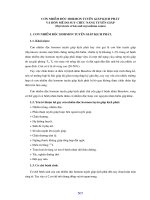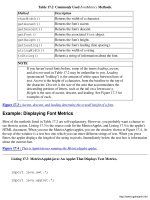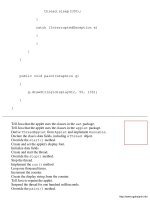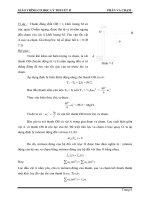GIÁO TRÌNH MARKETING NGHIÊN CỨU - PHẦN 17 ppt
Bạn đang xem bản rút gọn của tài liệu. Xem và tải ngay bản đầy đủ của tài liệu tại đây (761.75 KB, 42 trang )
Testing for Differences
Between Two Groups or
Among More than Two
Groups
Ch 17 2
Why Differences are Important
•
Market segmentation holds that
within a market, there are different
types of consumers who have
different requirements, and these
differences can be the bases of
marketing strategies.
Ch 17 3
Why Differences are Important
•
Some differences are obvious –
differences between teens’ and baby
boomers’ music preferences.
•
Other differences are not so obvious
and marketers who “discover” these
subtle differences may take
advantage of huge gains in the
marketplace.
Ch 17 4
Why Differences are Important
Market Segmentation
•
Differences must be statistically
significant
–
Statistical significance of
differences: the differences in the
sample(s) may be assumed to
exist in the population(s) from
which the random samples are
drawn
Ch 17 5
Why Differences are Important
Market Segmentation
•
Differences must be meaningful
–
Meaningful difference: one that the
marketing manager can potentially
use as a basis for marketing
decisions
Ch 17 6
Why Differences are Important
Market Segmentation
•
Differences should be stable
–
Stable difference: one that will be
in place for the foreseeable future
•
Differences must be actionable
–
Actionable difference: the marketer
can focus various marketing
strategies and tactics, such as
advertising, on the market
segments to accentuate the
differences between segments
Ch 17 7
Small Sample Sizes:
The Use of a t Test or a z Test
•
Most of the equations in this chapter will
lead to the computation of a z value.
•
There are certain circumstances in
which the z test is not appropriate.
•
The t-test should be used when the
sample size is 30 or less.
•
The t-test is defined as the statistical
inference test to be used with small
sample sizes (n is less than or equal to
30).
Ch 17 8
Determining Statistical
Significance: The P value
•
Statistical tests generate some
critical value usually identified by
some letter; i.e., z, t or F.
•
Associated with the value will be a p
value which stands for probability of
supporting the null hypothesis (no
difference or no association).
•
If the probability of supporting the null
hypothesis is low, say 0.05 or less,
we have significance!
Ch 17 9
Determining Statistical
Significance: The P value
•
P values are often identified in SPSS
with abbreviations such as “Sig.” or
“Prob.”
•
P values range from 0 to 1.0.
•
See MRI 17.1 on page 491.
Ch 17 10
Some Example P Values and
Their Meaning
•
First, we MUST determine the
amount of sampling error we are
willing to accept and still say the
results are significant. Convention is
5% (0.05), and this is known as the
“alpha error.”
Ch 17 11
Some Example P Values and
Their Meaning
•
P=0.05…
•
P=0.01…
•
P=0.10…
•
P=0.051…
•
P=0.99…
significant
significant
not significant
not significant
not significant
Ch 17 12
Testing Differences:
Percentages or Means?
•
There are statistical tests for when a
researcher wants to compare the
means or percentages of two
different groups or samples.
•
Percentages are calculated for
questions with nominal or ordinal
level of measurement.
•
Means are calculated for questions
with interval or ratio (metric level of
measurement.)
Ch 17 13
Testing the Difference Between
Two Percentages
•
Null hypothesis: no difference
between the means being compared
•
Alternative hypothesis: a true
difference between the compared
means
Ch 17 14
Testing the Difference Between
Two Percentages
•
Finding if the difference between two
percentages is significant?
–
Finding arithmetic differences
between %s.
–
Translate the difference into
number of standard errors from
hypothesized value of 0.
–
Make an assessment of the
probability of support for the null
hypothesis. See formula…
Ch 17 15
Testing the Difference Between
Two Percentages (p. 492)
•
Formula for significance of the
difference between two percentages:
Ch 17 16
How do you know when the
results are significant?
•
If the null hypothesis is true we would
expect there to be 0 differences
between the two percentages.
•
Yet we know that, in any given study,
differences may be expected due to
sampling error.
•
IF the null hypothesis were true, we
would expect 95% of the z scores
computed from 100 samples to fall
between + and -1.96 standard errors.
Ch 17 17
How do you know when the
results are significant?
•
IF the computed z value is greater
than + or -1.96, it is not likely that the
null hypothesis of no difference is
true. Rather, it is likely that there is a
real statistical difference between the
two percentages.
Ch 17 18
Tests of Differences between the
Percents of 2 Groups
-1.96
+1.96
2.5%
2.5%
95%
Supported
Not Supported Not Supported
p
1
= p
2
p
1
> p
2p
1
< p
2
Ch 17 19
An Example: Testing the Difference
Between Two Percentages (p. 495)
•
Last year a Harris Poll showed 40%
of surveyed companies were coming
to college campuses to hire seniors
(n=400 companies surveyed).
•
This year, the Harris Poll reported the
percentage is 65% (n=100
companies surveyed).
•
Is this a significant difference?
Ch 17 20
An Example: Testing the Difference
Between Two Percentages (p. 495)
•
Applying the formula: P
1
=65 and
P
2
=40
•
Z=4.51
•
Since the z value is greater than + or
-1.96, the difference between the two
percentages is significant!
Ch 17 21
Using SPSS to Test the Difference
Between Two Percentages
•
SPSS does not perform tests of
significance of the difference
between the percentages of two
groups, but you can use SPSS to
generate the relevant information and
perform a hand calculation.
•
ANALYZE, FREQUENCIES will
produce the percentages you need.
Ch 17 22
Testing the Difference Between
Two Means
•
The procedure for testing the significance
of difference between two means from
two different samples is identical to the
procedure for testing two percentages.
•
Equations differ due to the use of a
metric (interval or ratio) scale.
•
Note: Only use this test with large
samples (30+).
Ch 17 23
An Example
•
Sports Soft Drinks: the difference
between males (9) and females (7.5)
is significant; z =6.43.
Ch 17 24
Using SPSS to Test Differences
Between Two Group Means
•
The t-test is used to compare
differences between two means
(remember: “t for two”).
•
But the types of t-test depends upon
whether the two groups upon which
the means are calculated are
independent (separate groups) or
paired (the same group).
Ch 17 25
Using SPSS to Test Differences
Between Two Group Means
•
If the two groups are different, i.e.,
males vs. females, you would use
INDEPENDENT SAMPLES t-test.
•
If the two groups are from the same
sample, you would use PAIRED
SAMPLES t-test.









